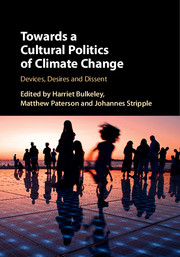Book contents
- Towards a Cultural Politics of Climate Change
- Towards a Cultural Politics of Climate Change
- Copyright page
- Contents
- Figures
- Contributors
- Acronyms and Abbreviations
- Acknowledgments
- 1 Introduction
- 2 CHANGE: The European Commission’s Climate Campaign as a Technique of Government
- 3 Devising Low-Carbon Desires in the Australian Urban Economy
- 4 Low-Carbon Devices and Desires in Community Housing Retrofit
- 5 Caring for the Low-Carbon Self: The Government of Self and Others in the World as a Gas Greenhouse
- 6 Grief, Loss and the Cultural Politics of Climate Change
- 7 Culture, Technology, and Transport: Navigating a Path to Low-Carbon Urban Mobilities in the United States
- 8 “The Everyday Choices We Make Matter”: Urban Climate Politics and the Postpolitics of Responsibility and Action
- 9 Strategic Engagements with Resistance Against Energy-Efficient Devices – Exploring the Hidden Politics of Comfort Desires in Housing
- 10 The Directionality of Desire in the Economy of Qualities: The Case of Retailers, Refrigeration and Reconstituted Orange Juice
- 11 The Making of a Zero-Carbon Home
- 12 Wind Power Activism: Epistemic Struggles in the Formation of Eco-Ethical Selves at Vattenfall
- 13 Conclusions
- References
- Index
- References
References
Published online by Cambridge University Press: 05 September 2016
- Towards a Cultural Politics of Climate Change
- Towards a Cultural Politics of Climate Change
- Copyright page
- Contents
- Figures
- Contributors
- Acronyms and Abbreviations
- Acknowledgments
- 1 Introduction
- 2 CHANGE: The European Commission’s Climate Campaign as a Technique of Government
- 3 Devising Low-Carbon Desires in the Australian Urban Economy
- 4 Low-Carbon Devices and Desires in Community Housing Retrofit
- 5 Caring for the Low-Carbon Self: The Government of Self and Others in the World as a Gas Greenhouse
- 6 Grief, Loss and the Cultural Politics of Climate Change
- 7 Culture, Technology, and Transport: Navigating a Path to Low-Carbon Urban Mobilities in the United States
- 8 “The Everyday Choices We Make Matter”: Urban Climate Politics and the Postpolitics of Responsibility and Action
- 9 Strategic Engagements with Resistance Against Energy-Efficient Devices – Exploring the Hidden Politics of Comfort Desires in Housing
- 10 The Directionality of Desire in the Economy of Qualities: The Case of Retailers, Refrigeration and Reconstituted Orange Juice
- 11 The Making of a Zero-Carbon Home
- 12 Wind Power Activism: Epistemic Struggles in the Formation of Eco-Ethical Selves at Vattenfall
- 13 Conclusions
- References
- Index
- References
- Type
- Chapter
- Information
- Towards a Cultural Politics of Climate ChangeDevices, Desires and Dissent, pp. 198 - 225Publisher: Cambridge University PressPrint publication year: 2016



